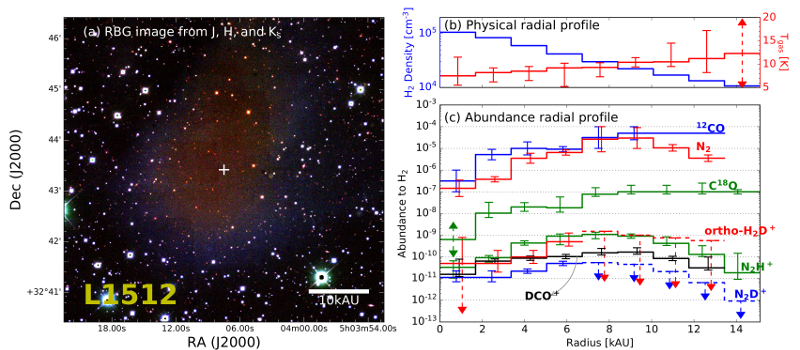| EPoS Contribution |
|
Physical and chemical modeling of a starless core: L1512
Sheng-Jun Lin NTHU, Hsinchu, TW | |
| The deuterium fractionation in starless cores gives us a clue to estimate their lifetime scales, thus allowing us to distinguish between different dynamical theories of core formation. In order to constrain the lifetime scale, we perform chemical modeling of the deuteration profiles across L1512 based on dust extinction measurements from near-infrared observations and non-local thermal equilibrium radiative transfer with multiple line observations of N2H+, N2D+, DCO+, C18O, and 13CO, plus H2D+ (110-111). We find a peak density of 1.1×105 cm-3 and a central temperature of 7.5±1 K. The depletion factors of N2H+ and N2D+ are 27+17-13 and 4+2-1 in L 1512, intermediate between the two other more advanced and denser starless core cases, L 183 and L 1544. These factors also indicate a similar freeze-out of N2 in L1512, compared to the two others despite a peak density one to two orders of magnitude lower. Retrieving CO and N2 abundance profiles with the model, we find that CO has a depletion factor of ∼430-870 and the N2 profile is similar to that of CO, suggesting that L1512 has probably been living long enough so that N2 chemistry has reached steady state. We conclude that L1512 is presumably older than 1.4 Myr. Therefore, the dominating core formation mechanism should be a slow process, such as ambipolar diffusion. | |
 | |
| Caption: The physcial and chemical structure in the starless core L1512. (a) The RGB combination image using J(blue), H(green), Ks(red) bands shows the cloudshine in L1512. (b) Physical and (c) abundance radial profiles are derived with our radiative transfer model except for that CO and N2 abundance profiles are derived from our time-dependent chemical model. | |
| Collaborators: L. Pagani, LERMA, FR S.-P. Lai, NTHU, TW C. Lefevre, IRAM, FR F. Lique, LOMC, FR |
Suggested Session:
Cores |

